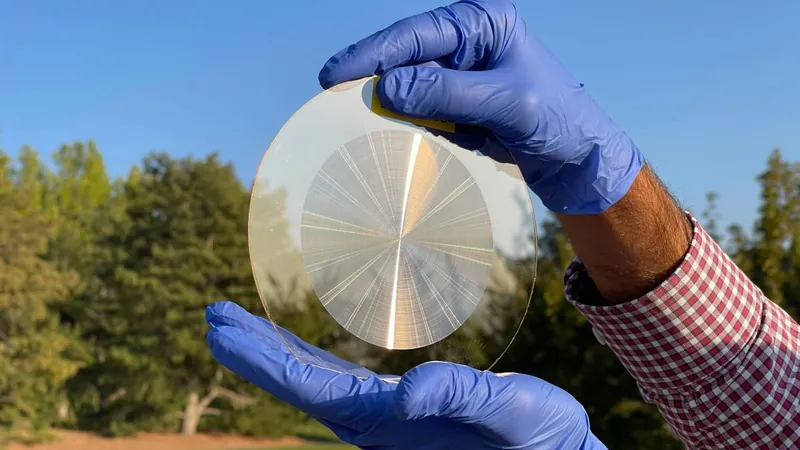
Revolutionizing Space Exploration: The Game-Changing Flat Telescope Lens Set to Transform Deep-Space Imaging
2025-03-28
Author: Yu
Groundbreaking Innovation in Telescope Technology
A groundbreaking innovation in telescope technology could soon make deep-space stargazing more accessible and efficient than ever before. Scientists have developed a new type of flat, razor-thin lens that promises to enable lightweight yet powerful telescopes to be mounted on aircraft and satellites, vastly improving our ability to capture detailed images of distant celestial objects.
The Challenges of Traditional Lenses
Traditionally, refractor telescopes employ curved lenses that magnify far-off objects through a process known as refraction. This technique bends light to a focal point, allowing for larger-than-life views of galaxies and stars. However, conventional lenses can be cumbersome and unwieldy, especially when tasked with observing objects millions of light-years away.
As distance increases, so does the necessity for higher magnification, which in turn demands thicker and heavier lenses. For this reason, researchers have been exploring the potential of flat lenses, which offer lighter and less bulky alternatives. Yet, the transition from curved to flat presents significant challenges, as light behaves differently when passing through these types of lenses.
Introducing the Multilevel Diffractive Lens (MDL)
The innovative "multilevel diffractive lens" (MDL) is the latest breakthrough, structured with microscopically small concentric rings that adeptly direct various wavelengths of light toward a common focal point. This unique design delivers sharp, accurate images while eliminating common issues of color distortion typically associated with flat lenses.
The newly developed MDL measures 100 millimeters in diameter with a 200 mm focal length, all while being just 2.4 micrometers thick. It has been specifically optimized for the visible light spectrum, ranging from 400 to 800 nanometers. This significant reduction in weight, compared to traditional curved lenses, is expected to improve efficiency in astronomical imaging.
Expert Insights and Future Implications
According to the lead study author, Apratim Majumder, an assistant professor of electrical and computer engineering at the University of Utah, this discovery is a crucial step towards creating large-aperture, lightweight flat lenses capable of producing full-color images suitable for air- and space-based telescopes. The findings of this research, which were published on February 3 in the journal *Applied Physics Letters*, were funded by notable organizations including the Defense Advanced Research Projects Agency (DARPA), NASA, and the Office of Naval Research.
Historically, flat lenses such as the Fresnel zone plate (FZP) have been used in imaging; however, the ridges on existing flat lenses often lead to color distortions, rendering them less effective. Unlike FZPs, the MDL’s design allows for varying depths of its concentric rings, enabling precise control over how wavelengths diffract. This meticulous control means that a spectrum of colors can be brought into focus simultaneously, resulting in brilliantly clear and accurate images.
Captivating Imaging Results
As a testament to its capabilities, the researchers used the MDL to capture stunning images of the sun and the moon, revealing intricate geological features on the lunar surface and detailed observations of solar phenomena like sunspots.
Majumder stated, “The simulation of these lenses required solving extensive computational problems due to the complex data involved. After optimizing the microstructure design, precise manufacturing processes became essential to ensure quality and stability.”
Broader Applications and Future Development
The implications of this transformative technology extend far beyond astronomy, including possible applications in astrophotography and various long-range imaging tasks for both airborne and space-based platforms. Given the rapid advancements in this field, mass production of the MDL may soon become a reality — paving the way for a new era in space exploration and imaging.
With the potential to reshape our understanding of the universe, this innovative lens could very well be the key to unlocking the mysteries of deep space. Keep an eye out for future developments as production rapidly approaches!



 Brasil (PT)
Brasil (PT)
 Canada (EN)
Canada (EN)
 Chile (ES)
Chile (ES)
 Česko (CS)
Česko (CS)
 대한민국 (KO)
대한민국 (KO)
 España (ES)
España (ES)
 France (FR)
France (FR)
 Hong Kong (EN)
Hong Kong (EN)
 Italia (IT)
Italia (IT)
 日本 (JA)
日本 (JA)
 Magyarország (HU)
Magyarország (HU)
 Norge (NO)
Norge (NO)
 Polska (PL)
Polska (PL)
 Schweiz (DE)
Schweiz (DE)
 Singapore (EN)
Singapore (EN)
 Sverige (SV)
Sverige (SV)
 Suomi (FI)
Suomi (FI)
 Türkiye (TR)
Türkiye (TR)
 الإمارات العربية المتحدة (AR)
الإمارات العربية المتحدة (AR)